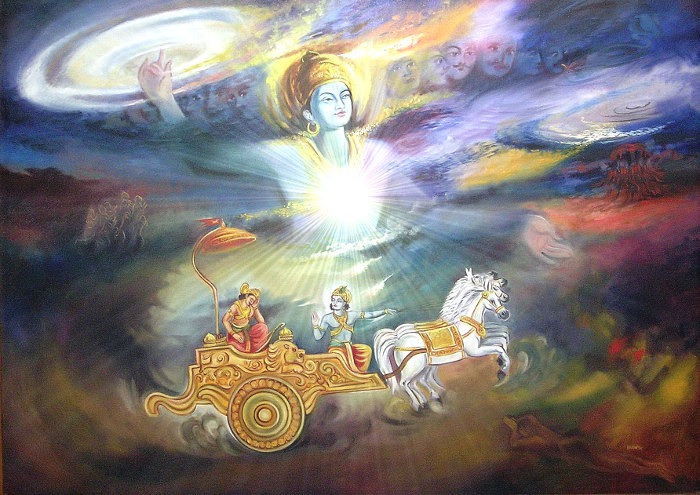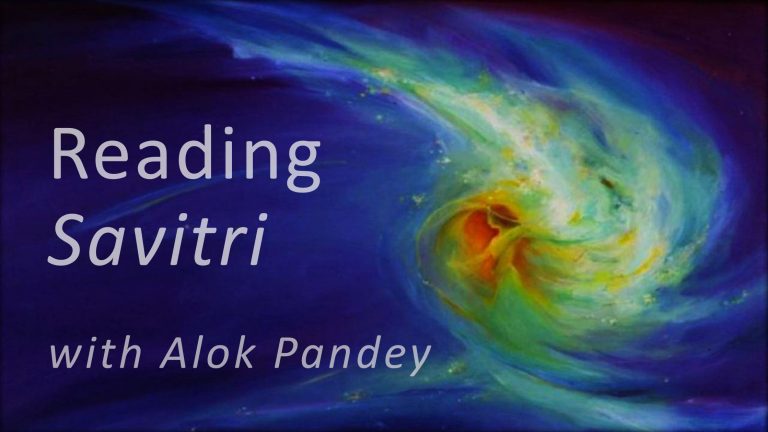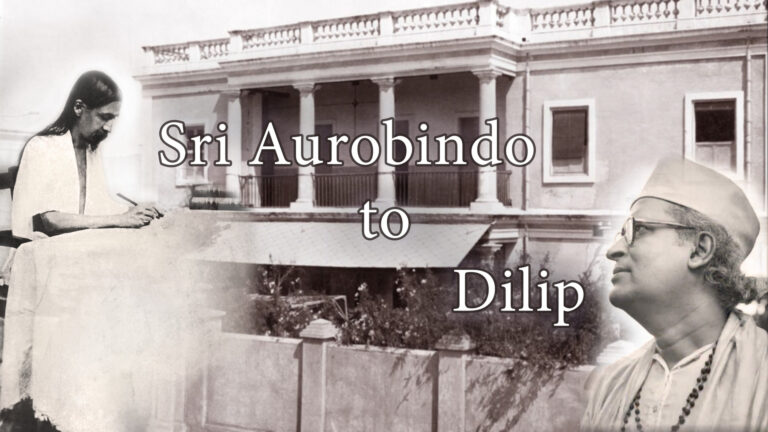 Sri Krishna of course is the center of the entire scene. The epic in a way revolves around him. Even though to the ordinary eye of man his action in the actual war seems to be limited, the sage and seers know it is he who is conducting the war even though sitting unarmed on the chariot in the battlefield of life. He is conducting the war not by outer means as much as by the silent impersonal Will that a yogin has access to. It is this Will that drives the stars and the sun and the moon and earth on their course. It is this Will that orders the atoms and the galaxies in their orbits. It is this Will that awakens as life in the plant and animal, blooms in the flower, flows in the river and stands erect and lofty in the mountain ranges high. It is this Will that climbs as thought in man, kindles within him the fire of aspiration and leads him on the inner paths towards God and Freedom and Truth and Bliss and Immortality. It is this Will that labours in the whole creation as Love. Though the scientist sees it an something mechanical since he is not yet blessed with the divine vision as Sanjay has or which a yogi like Vyasa develops, hidden behind this mechanical energy in the atom and man there is a Conscious Force that arranges all the events and circumstances of individual and collective life. Random though they seem, there is behind them the workings of a deep cosmic Intelligence, a Wisdom from the heights, pragya purusho purano, that one can realise through yoga. Once we know this Will and align our acts to Its rhythms then life flows beautifully as it catches hold of the secret music that rings in our soul. Then even the battle of Kurukshetra becomes a tremendous means for our growth. It is this Divine Will that Sri Krishna embodies on the great battlefield of Kurukshetra.
Sri Krishna of course is the center of the entire scene. The epic in a way revolves around him. Even though to the ordinary eye of man his action in the actual war seems to be limited, the sage and seers know it is he who is conducting the war even though sitting unarmed on the chariot in the battlefield of life. He is conducting the war not by outer means as much as by the silent impersonal Will that a yogin has access to. It is this Will that drives the stars and the sun and the moon and earth on their course. It is this Will that orders the atoms and the galaxies in their orbits. It is this Will that awakens as life in the plant and animal, blooms in the flower, flows in the river and stands erect and lofty in the mountain ranges high. It is this Will that climbs as thought in man, kindles within him the fire of aspiration and leads him on the inner paths towards God and Freedom and Truth and Bliss and Immortality. It is this Will that labours in the whole creation as Love. Though the scientist sees it an something mechanical since he is not yet blessed with the divine vision as Sanjay has or which a yogi like Vyasa develops, hidden behind this mechanical energy in the atom and man there is a Conscious Force that arranges all the events and circumstances of individual and collective life. Random though they seem, there is behind them the workings of a deep cosmic Intelligence, a Wisdom from the heights, pragya purusho purano, that one can realise through yoga. Once we know this Will and align our acts to Its rhythms then life flows beautifully as it catches hold of the secret music that rings in our soul. Then even the battle of Kurukshetra becomes a tremendous means for our growth. It is this Divine Will that Sri Krishna embodies on the great battlefield of Kurukshetra.
The Gita is His teaching of the various ways and means through which man can and must align to this Divine Will that is operating within us and within the world. In aligning to It, rather than living by our mental standards which are but partial and shadowy gleams, is how man can find his ultimate salvation, not an other-worldly “Moksha” by shunning the world existence but a “Moksha” here and now even while engaged in all the various activities of life. He can live his life as a “jivanmukta” if his heart and mind and human can attune to this Divine Will within. But first we must disabuse ourselves of all that distorts this Will within us. This distortion arises due the intrusion of ego and desire. It is this that is the cause of our suffering.
The first thing that the Gita teaches therefore, is to draw back the old ways of working of nature, its impulsions through the ego-self and desire. It teaches us “jnana yoga” so to say, by this we realise another self within us, our true Self which is One though it expresses itself in three-fold ways.
Next it teaches us “karma yoga”, the way of aligning ourselves to the Divine Will. It takes time and there is a whole process of it, which includes “nishkama karma” to take away the sting of desire, the practice of equanimity that further breaks the knot of the ego that distorts and falsifies our vision and action, constant remembrance and offering of all we think and feel and do, as a conscious sacrifice, “yajna” , to the Master of works. This purifies our nature of egoism and thereby prepares us for the direct divine action flowing through us.
Finally, it crowns its gospel with Bhakti Yoga through which we enter into an entire and completest possible union and communion with the Lord. When this happens, when our surrender is complete, then are we completely freed from all bondage to ignorance. Then whatever we do becomes a means of serving and loving and adoring and worshipping the Eternal until all in us becomes one with His Being, one with His Consciousness, one with His vast Delight. Sri Krishna comes to reveal all this to man through Arjuna.



